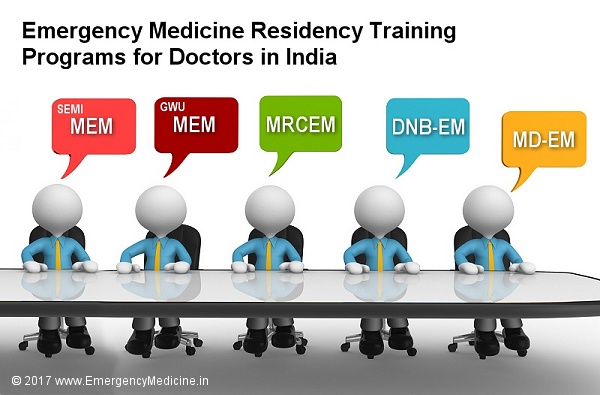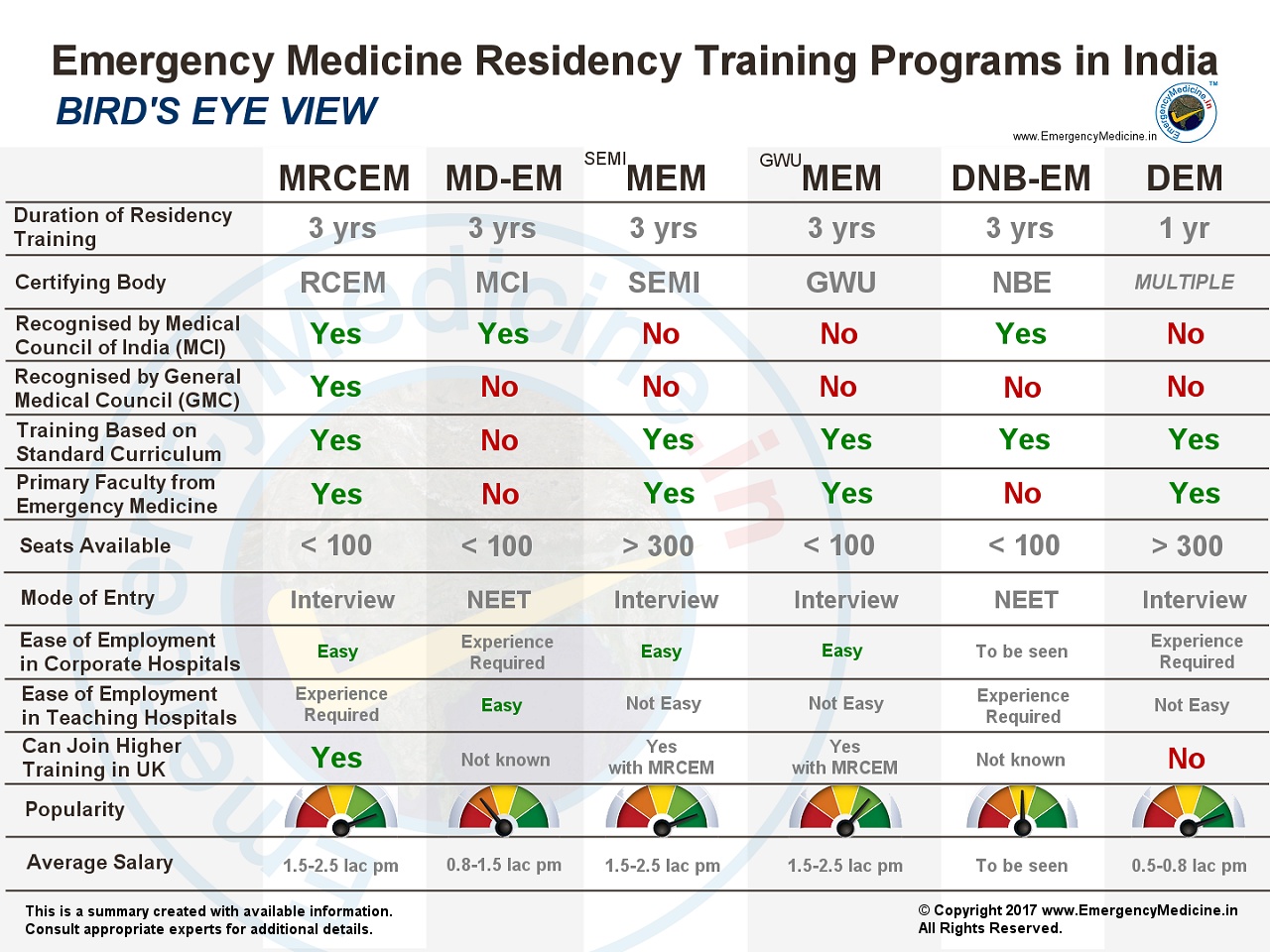Deciphering Emergency Medicine Training Programs in India
Posted by webmaster on July 17 2017 09:59:20
Deciphering Emergency Medicine Training Programs in India.
16-Jul-2017
Editors Desk 
Reference/share this article - http://www.emergencymedicine.in/current/news.php?readmore=199

The emergency medicine (EM) academic engine is running in India since the late 90s, when the first 1 year structured Fellowship programs in EM (FEM) took birth at Christian Medical College (CMC) Vellore, Johns Medical College Bangalore, and Apollo Hospitals Hyderabad. Apart from FEM (also known as Diploma EM or DEM), six other important initiatives are responsible for churning out trained and qualified emergency physicians in the country.
1 - Institutes like Sri Ramachandra Medical College at Chennai, Vinayaka Mission Hospital at Salem, and others, began the first 3 year MD (Accident & Emergency Medicine) or MD (A&E) which was placed under regulations of respective college Universities. These deemed university MD (A&E) programs were in existence when Medical Council of India (MCI) had not recognized EM. The first 3-year residency qualified EM physicians are from these MD (A&E) programs and they remain a formidable workforce in EM even today. MD(A&E) is no longer available.
2 - The collaboration of Apollo Hospitals with the Royal College of Emergency Medicine (RCEM) UK, resulted in the start of the 3 year MRCEM residency training program at Apollo Hospitals Hyderabad in 2005, and opening of RCEM overseas examination centers at Hyderabad and other cities. Apollo hospitals in 4 other cities also started the same training in 2010. MRCEM has remained highly credible due to its difficult examinations and its recognition by the MCI.
3 - George Washington University (GWU) USA, in association with various private hospitals in Kerala, New Delhi, Kolkata and Durgapur, launched a 2 year International Fellowship in EM in 2007. This program was later upgraded to become the 3 year Masters in Emergency Medicine (GWU-MEM). GWU-MEM is popular for its visiting international faculty.
4 - The Society for Emergency Medicine India (SEMI), which was already running 1 year DEM, also formally announced the start of its 3 year Masters in Emergency Medicine (SEMI-MEM) at Columbia Asia Hospitals Bangalore in 2011. SEMI-MEM training programs have been rapidly adopted by more than 100 hospitals across India, primarily due its extremely low training fees and strict standards maintained.
5 - EM specialty was officially recognised by the MCI in July 2009, and the first MD-EM postgraduate training (recognised by MCI) commenced at B J Medical College and NHL hospital, Gujarat, in June 2010. MD-EM was welcomed by the entire EM community as it signified official recognition. However, scarcity of seats, teaching by non-EM faculty and high capitation fees (in some colleges) have reduced this program's popularity.
6 - The National Board of Examinations (NBE), which is an independent academic body in India, also recognised EM in July 2013 and took their first trainees under DNB-EM postgraduate training in October 2014. Hospitals which were running MEM programs facilitated the adoption of DNB-EM. Teaching by non-EM faculty has put the future of DNB-EM under threat.
___________________________________________________________________________________
The resultant EM physicians have not only brought quality emergency patient care within their own EM departments, but also helped the academic spread of the EM specialty. Majority of them, especially doctors from the first four groups, are doing incredible work within the domain of EM and its sub-specialties, including EMS. Their growth has been widespread, persistent, effective and silent.
It is important to note that both MCI and NBE, in order to adhere to their uniform teaching regulations, made a fundamental error in program design for EM specialty. They designated doctors from other medical/surgical specialties (i.e internal medicine, general surgery, anesthesia, respiratory medicine and orthopedics) to teach EM to new trainees. Such a move may mirror decisions made in the past, in Western countries, but many believe this is completely unnecessary especially when experienced EM faculty are already available in abundance in India. It is for this reason that the true EM faculty have gyrated towards non-MCI and non-NBE programs and elevated the quality of EM trainees enrolled in these programs.
Today there are multiple pathways and mixed opportunities for a career in EM in India. A birds eye view of the current training programs can be seen in the image below. This would help any interested person to get a fair initial comparison. The compiled statistics is as per data available in first half of 2017. Online distance education programs like FACEE, etc are excluded in this comparison as they do not impart EM residency training.

Click on image to view at full resolution 1280x960
___________________________________________________
Update on Dec 2017
Use the link below to reference or share this article
http://www.emergencymedicine.in/current/news.php?readmore=199
___________________________________________________
Copyright ©2017 EmergencyMedicine.in All Rights Reserved.
Unauthorized reproduction of this article is prohibited without written permission from the administrator
.


